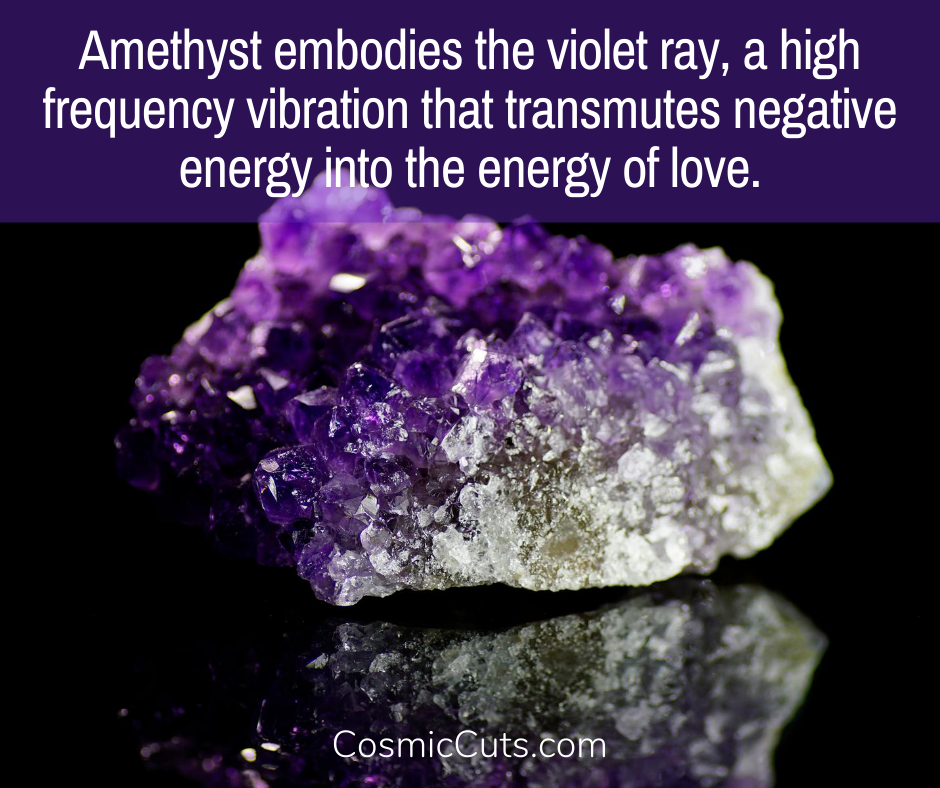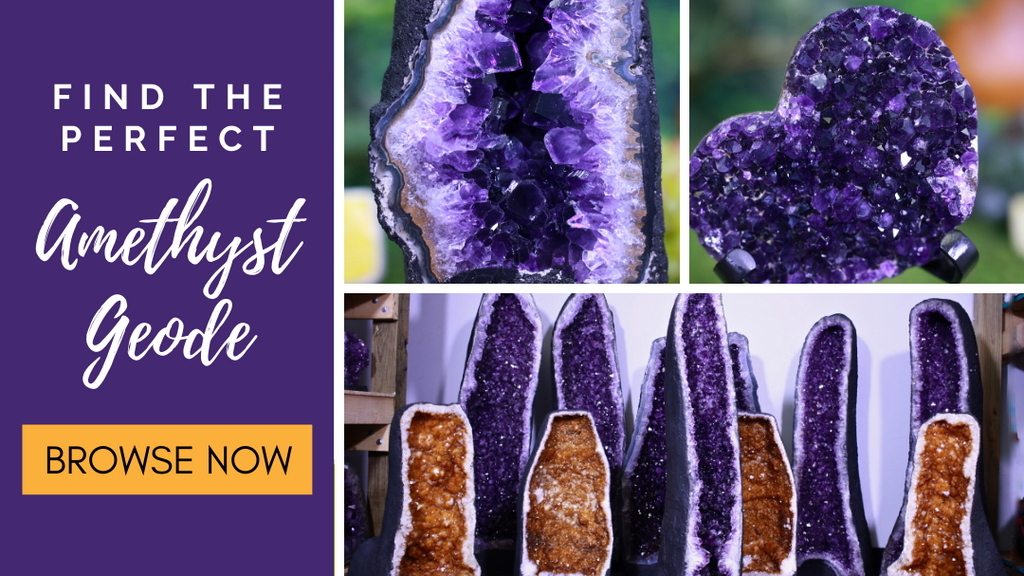
Amethyst Symbolism Through the Ages & What it Means for Us Today
INSIDE: By learning about Amethyst symbolism, the history of Amethyst, and all of the folklore, legends, and mythology that surrounds it, you'll come to realize why it is such a precious and beloved gemstone.
The Gem of Fire... A Stone of Royalty... The Bishop's Stone... a Dream Stone.
These are just a few of the names bestowed upon the Amethyst crystal.
But why?
Discovering the legends, mythology, and folklore that stems from the history of Amethyst brings a whole new understanding to this beautiful stone.
Amethyst Symbolism in Regards to Healing Properties
Before we dig into all of the Amethyst legends, lore, and mythology, let's first answer the question, what does Amethyst symbolize in terms of healing powers?
Here are the main healing powers that Amethyst is known for...
- Spiritual insight and intuition
- Relaxation, peace, calm, and tranquility
- Protection
- Purification
- Love
But where did all of this come from?
Let's look back to the history of Amethyst to understand the Amethyst symbolism behind it all.
The History of Amethyst
There is proof of Amethyst being used as far back as 25,000 B.C. and it has always been a prominent stone throughout our history all over the world.
Until large amounts of Amethyst was found, it was a considered precious stone that was equal in value to the diamond. It has since been downgraded to a semi-precious stone since it is more readily available.
A Gem of Fire
In ancient times, Amethyst was known as a "Gem of Fire," because it was thought to hold the energy of fire, which is passionate, creative, and spiritual in nature.
A Stone of Royalty
As a stone of royalty, it was used in crowns, scepters, and jewelry by the royal house because it helped leaders with decision-making and gave clergymen the power of restraint so that they could uphold their vows of celibacy.
The Ancient Egyptians & Amethyst Symbolism
In Ancient Egypt, Amethyst was known as "Hemag." It was carved into hearts and worn as amulets during burial ceremonies.
It was also worn as amulets of protection by Egyptian travelers to keep them safe from being taken advantage of or attacked while away from home.
The Egyptians used it for healing fears and guilt as well.
Symbolism of Amethyst & the Hebrews
The Hebrews called Amethyst "Ahlamah," which was derived from the Hebrew word, "halam," which means "to dream."
To this day, it is known as a Dream Stone that can help deter nightmares while assisting us in having more positive, vivid dreams.
Catholic Amethyst Symbolism
In the Catholic religion, Amethyst was used in prayer beads and rosaries.
It was known as the Bishop's Stone because it symbolized ecclesiastical dignity. Today, Bishops still wear it on the second finger of their right hand.
Eastern Cultures & Amethyst
In the Eastern world, Amethyst was used in the tree of life, in the gem cities, and in temples of worship. It was also used in offerings and for spiritual practices and meditation.
Other Symbolism Examples Related to Amethyst Throughout History
- Amethyst was also known as a "Stone of Sobriety," helping to reduce indulgence in any form.
- It was thought to control evil thoughts.
- It was said to improve intelligence and business sense.
- It protected travelers from surprise attacks.
- It protected the body from disease and infection.
- It protected soldiers and helped them win wars.
- It protected against black magic and witchcraft.
- It was a necessary stone for astrology, helping to align planetary influences.
- It was placed under pillows to improve sleep and reduce nightmares.
- It was placed on the temples and forehead to reduce throbbing headaches.
- It was used as amulets and beads.
Click here to learn about the history of other crystals.

Amethyst Legends, Lore & Mythology
Amethyst is a stone that is rich in mythology, legends, and folklore. Let's look at some of the most intriguing ones now...
The Mythology of Bacchus (or Dionysus)
The name, "Amethyst," comes from the Greek word, "ametusthos," which means "not intoxicated."
And the legend of Bacchus, the Roman wine god (otherwise known as Dionysus) explains this...
The story goes that a young maiden named Amethyst was on her way to worship at the Temple of Diana (otherwise known as Artemis) when she happened upon the god of wine.
He had vowed to take revenge on the next person he saw to rid himself of anger over an insult by a puny human.
As he sent his guardian tigers to devour her, the goddess, Diana spared her by turning her into a clear stone.
This caused Bacchus to feel remorse and he poured his wine over the stone to atone for his actions, which turned the stone a deep violet color.
This legend was created during the time of the Renaissance in 1576 by Remy Belleau, a French poet as part of a poem about gemstone beliefs.
However, it is not the reason for the belief that Amethyst prevents drunkenness and overindulgence. That goes back to the time of Ancient Greece.
In Ancient Greece and Rome, they would drink from Amethyst-studded goblets because they believed it would allow them to drink all night and remain sober.
They also wore stones in the navel area to reduce overindulgence of any nature.
Catholic bishops were known to wear Amethyst rings to protect them from "mystical intoxication." That's where the kissing of the ring came from; it was thought that it would protect the kisser in the same way.
The Legend of St. Valentine
Amethyst is known as the stone of St. Valentine because he wore an Amethyst ring in the shape of cupid, which was meant to symbolize fidelity, eternity, and deeper loving connections.
Valentine's Day was originally a Christian holiday, celebrating St. Valentine who was martyred on February 14 in the year 269 (he was named a Saint in 496).
At that time, there were laws in place that forbade young men from marrying so that they would instead serve as soldiers. Valentine wore his Amethyst ring as a signal that he would marry them in secret, and he was imprisoned because of it.
Valentine's Day became a romantic holiday in the 17th century. It is thought that this happened as a result of a poem called "Parliament of Foules" written by Geoffrey Chaucer, which was about birds finding their mates on February 14th.
Christianity & Crucifixion
In Christianity, Amethyst is associated with Christ, as it is the color that represents the purifying effects of suffering (the suffering of Christ's wounds during the crucifixion).
Therefore, it was used by the Christians to heal wounds.
Other Amethyst Legends & Lore
There are many other legends and myths that give meaning to Amethyst symbolism. Let's look at a few now...
- To Deter Witchcraft - In Peru, Amethyst was used in a ritual to ward off witchcraft. They would engrave the name of the sun and moon on the Amethyst and hang it around their neck with a baboon's hair or a swallow's feather.
- Love Spells - By speaking the name of the person they loved into Amethyst it would summon their love, even if they were committed to another.
- To Protect Against Dark Magic - Amethyst was used for protection against black magic and witchcraft. It was said to lighten in color when placed near an attacker.
- Deterring Demons, Drunkenness & Fleas - By engraving an Amethyst with a bear, it was thought that it would send demons away, reduce drunkenness, and keep animal fleas away.
- North-East Point on the Medicine Wheel - Amethyst was used as the North-East point on a medicine wheel to bring about balance and healing. It was said to help with decision-making, meditating, spiritual guidance, logic, realism, new ideas, emotional balance, centering, and awakening.
Spiritual Aspects of Amethyst Symbolism
Amethyst is a high vibrational stone that brings a lot of spiritual symbolism with it. Now, we'll dig into this aspect of Amethyst symbolism...
Amethyst & The Violet Ray
Amethyst embodies the violet ray, otherwise known as the violet flame vibration.
It's a high frequency vibration that has the ability to transmute negative energy into the energy of love. This is what allows Amethyst to raise your vibration and the vibration of your environment.
The violet ray is a firey energy that brings passion and emotion. It stimulates the intuition, imagination, insight, perception, and creativity. It improves self-confidence and helps us with soul searching and understanding ourselves.
Amethyst & the Spiritual Altar
Because of its beauty and versatile healing properties, an Amethyst Geode is often the focal point of an altar.
Place a large Amethyst Geode on your spiritual altar to aid in your spiritual endeavors. It will cleanse the other crystals you place near it, and it will raise your vibration and the frequency of your environment.

Angels & Amethyst Symbolism
There are numerous angels that are associated with the Amethyst, many of which you have probably never heard of, including:
- Ambriel
- Amnixiel
- Atheniel
- Aziel
- Barachiel
- Cahatel
- Cassiel
- Habuhian
- Hagiel
- Hahaiah
- Jazeriel
- Jeremiel
- Lelahiah
- Mitzrael
- Manake
- Mastema
- Menadel
- Michael
- Nuriel
- Phorlach
- Scheliel
- Sheratiel
- Tagriel
- Taliahad
- Vahuel
The Symbolism of Amethyst & Goddesses
There are two goddesses that are associated with Amethyst symbolism:
- Artemis - The Greek goddess of wild animals, the hunt, and vegetation. She is also the goddess of chastity and childbirth. She represents the love of forests and mountains, the protector of the animals, and she comforts women in labor.
- Diana - It is believed that Diana is the Roman version of Artemis.
Talismans & Amethyst Symbology
Amethyst can be used as sacred talismans with almost magical powers. For example, it has been used in the following ways:
- As a Seeker stone, which means it brings about new beginnings, ideas and solutions. That makes it the perfect stone for adventurers, hunters, explorers, scientists, students, and researchers.
- As a Transformer stone, helping us to grow, evolve, and make important changes in our lives.
What Does Amethyst Represent in Regards to the Tarot?
Amethyst is associated with the Temperance card in Tarot, which symbolizes balance in terms of overindulgence, smoking, drinking, drug addictions, sexual addictions, food addictions, etc.
Amethyst is often kept with Tarot cards and other divination tools to amplify their powers and your intuition when using them.
Amethyst Symbolism in Feng Shui
In Feng Shui meaning, Amethyst symbolizes Fire energy. It brings its user warmth, radiance, motivation, illumination, passion, and forward moving action.
It is a Yang energy, which is masculine creative energy, helping to bring forth ideas, knowledge, solutions, and sexual energy.
Fire energy objects are often placed in the South area of the home or room, which is known as the Fame and Reputation area. Placing Amethyst in this area can help to improve your reputation in your community and your family.
What Does All of This Amethyst Symbolism Mean For Us Today?
When we look at Amethyst symbolism today, not much has changed. For the most part, it is still being used in the same ways.
For example, it continues to be used in the following ways:
- To merge intuition and intellect
- To settle the mind and go deeper into meditation
- To improve psychic abilities
- To soothe and calm the mind, body, and spirit
- To feel uplifted and relaxed at the same time
- To improve decision-making
- To reduce stress
- To improve behaviors and reduce overindulgence
- To reduce insomnia and nightmares
- For protection in all forms
- To transmute negative energy
- To raise the vibration of a person or place
And it doesn't stop there. Amethyst is a very versatile stone that can be used for a number of different purposes.
Check out some of our other articles to learn more about what Amethyst can do for you:
The Most Complete Guide to Amethyst Healing Properties
The Remarkable Healing Powers of Amethyst Geodes
What is the Spiritual Meaning of Amethyst
How to Create Your Own Healing Spa
Unraveling the Magical Properties of Amethyst
Get to know your Amethyst and discover for yourself what it can do for you!
Final Thoughts on Amethyst Symbolism & History
Looking at Amethyst symbolism throughout the ages brings us in touch with just how beloved this crystal has been since the dawning of time. It's quite a blessing that Mother Nature has provided for us!
* Crystals and stones should not be used as a substitute for medical advice or treatment. Please read our full disclosure notice here.












